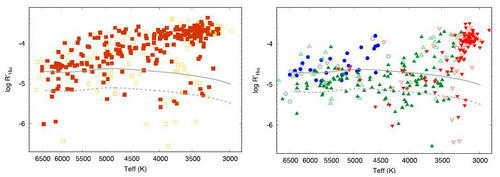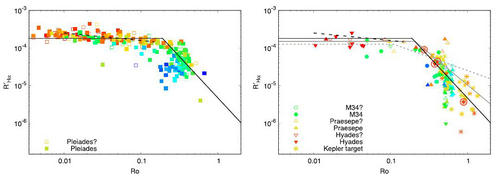Dr. Xiangsong Fang and Prof. Gang Zhao et al. from National Astronomical Observatories of CAS (NAOC) measured chromopsheric emission (excess emission) strength of Hα, Hβ, and Ca II K lines for these late-type stars with LAMOST, then analyzed the activity-age-rotation connection, as well as the correlation of chromopheirc activity, photospheric activity (such as spot coverage), and coronal emission (X-ray). Their results shed new light on the stellar magnetic activity issues.
Solar chromospheric activity consists of various phenomena, such as solar plage and solar flare. In fact, stellar chromospheric activity phenomena are ubiquitous in late-type stars. Recently, based on LAMOST DR3 spectral data, Fang et al. (2018, MNRAS, 476, 908) have studied the chromospheric activity for over 700 late-type stars in open clusters, Pleiades, M34, Praesepe and Hyades.
Open cluster members have an advantage for studying chromospheric activity properties in light of rotation-activity-age connection due to their homogeneity in chemical composition and age, thus the chromospheric activity in open clusters have got special attention. However, due to the limitation of sample stars used before in terms of mass coverage and available rotation periods, the behavior of chromospheric activity is still not well understood. LAMOST spectral survey allows the researchers to initiate a systematic study of chromospheric activity among late-type stars in different population. Based on LAMOST spectra, Fang et al. (2018) studied the behavior of chromospheric activity for over 700 late-type stars in four open clusters with different ages. After measuring and analyzing, they reveal that at a given age, stellar chromospheric activity was found to be overall increased as mass decreases. The activity level of GK-type stars declines steadily from 100 Myr (e.g. Pleiades) to about 700 Myr (Praesepe and Hyades); the activity lifetime for M1—M2-type stars is around 600—700 Myr.
There appear two chromospherc activity sequences among Pleiades GK-type stars, and Praesepe/Hyades M-type members; similar features were found in other activity indicators (spot coverage and coronal X-ray emission). Such activity sequences parallel with well-known rotation sequences. For slow rotating stars, chromospheric activity level increases sharply as rotation period decreases (rotating faster); a weak dependence of chromospheric emission on rotation exists among ultrafast rotators, showing a saturation-like feature. More interestingly, their analysis shows fully convective slow rotators obey the rotation–chromospheric activity relation similar to hotter stars.
They found correlations among Hα, Hβ, and Ca II K emissions, in which Hα losses are more important than Ca II K for cooler and more active stars. In addition, a weak correlation is seen between chromospheric emission and photospheric activity (spot filling factor and the amplitude of light variation) that shows dependence on stellar spectral type and activity level, which provides some clues on how spot configuration varies as a function of mass and activity level. A good correlation between chromospheric and coronal emissions was also detected that confirms previous findings.
This article has been published online in the Monthly Notices of the Astronomical Society.

Figure 1: Hα excess emission. Left: Pleiades; Right: M34 (blue symbols),Praesepe and Hyades (green and red symbols, respectively).

Figure 2: Hα excess fractional luminosity versus Rossby number (Ro). The colour indicates the effective temperature (from blue to red ~ from 6500K to 3000K).
News from:http://english.nao.cas.cn/ne2015/rn2015/201805/t20180522_192721.html